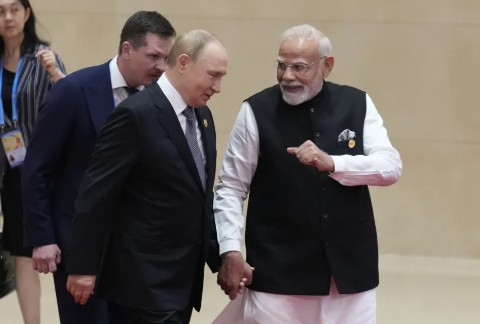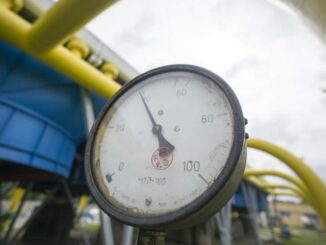
In a display of enduring alliance, Russian President Vladimir Putin and Indian Prime Minister Narendra Modi convened at the Shanghai Cooperation Organisation (SCO) summit in Tianjin, China, on September 1, 2025. Their meeting, marked by a warm hug and an impromptu hour-long car ride together, underscores a commitment to business and cooperation in key sectors like energy and trade.
As the world watches escalating U.S. tariffs and sanctions, this rendezvous signals that Russia and India are prioritizing practical deals over geopolitical pressures.
A Warm Embrace Amid Trade Winds
The leaders’ interaction began with Modi describing the encounter as “a delight,” followed by discussions on deepening bilateral ties in trade, fertilizers, space, security, and culture.
Putin and Modi also touched on the ongoing war in Ukraine, with Modi reiterating India’s calls for peace after recent talks with Ukrainian President Volodymyr Zelenskiy.
This comes against the backdrop of U.S. President Donald Trump’s administration lambasting India for its substantial purchases of Russian oil, which they claim funds Russia’s military efforts. In response, the U.S. has slapped 50% tariffs on Indian goods—the highest in Asia—aiming to curb these energy imports.
India, however, remains steadfast. Oil Minister Hardeep Puri has defended the purchases, noting they haven’t “broken rules” and have helped stabilize global energy prices by preventing spikes.
With Russia supplying around 37% of India’s crude oil needs in early 2025, these imports have surged from $2.31 billion in 2020 to $52.2 billion in 2024, bolstering India’s refining sector and exports of refined products worldwide.
The meeting hints at further solidification of these energy links, with Modi emphasizing a “special and privileged partnership” and plans for Putin’s visit to India later this year.
Echoes of the Alaska Summit: Business as a Path to Peace
This Sino-Indian-Russian alignment echoes the recent Alaska Summit on August 15, 2025, where Putin met with Trump in Anchorage to discuss easing sanctions and revitalizing trade.
Putin has openly expressed optimism about mending ties with the U.S., stating that Russia sees “light at the end of the tunnel” in relations and highlighting “tremendous potential” for investment and business cooperation.
He praised Trump’s peace efforts and floated ideas for nuclear deals and Arctic collaboration, signaling Russia’s eagerness to engage in joint ventures.
Energy News Beat has long advocated that such business deals could pave the way for ending the Ukraine war. By lifting sanctions, the U.S. and Russia could revive projects like Arctic LNG 2, enhancing Russia’s energy output while providing a stable supply to global markets. President Putin visited Alaska to conduct business deals, as evidenced by his decree prior to landing on the Sakhalin project with ExxonMobil.
Russia’s current production hovers near 9.01 million barrels per day, with constraints limiting surges, but collaborative efforts could add a gradual supply without destabilizing prices.
This approach—focusing on trade over conflict—could lower U.S. pump prices and foster peace by aligning economic interests, as the summit demonstrated a shift toward pragmatic negotiations.
Opening New Trading Blocs: US, India, and Russia Unite?
Imagine a trilateral energy pact: The U.S., India, and Russia forming new trading blocs through joint deals. Putin’s statements post-Alaska affirm his desire to do business with the U.S., noting enormous economic opportunities if relations normalize.
Bringing Putin to peace talks via incentives, rather than sanctions, could resolve Ukraine’s crisis while unlocking Arctic resources and Asian markets. India’s role is pivotal. As the third-largest oil consumer, projecting 4.7–5 million barrels per day in imports for 2025 with 3.2% growth, India bridges East and West.
Refiners like Reliance profit from discounted Russian crude, exporting refined products—even to the West—despite bans.
A U.S.-India-Russia bloc could stabilize energy flows, reduce Europe’s dependency shifts, and promote mutual gains in LNG, coal, and upstream projects.
The Boomerang Effect: Tariffs Hammering the US Dollar
Energy News Beat predicted this: Trump’s tariffs on India would boomerang, damaging the U.S. dollar more than intended.
By pushing India and Russia toward rupee-rouble trades, these measures accelerate de-dollarization within BRICS, where non-USD transactions now dominate two-thirds of intra-group trade.
This erodes petrodollar dominance, potentially raising U.S. inflation and borrowing costs as global demand for dollars wanes. Analysts like Irina Slav argue that sanctions fail, urging incentives for peace instead.
With India’s refining capacity expanding to 300 MMTPA by 2028 and exports hitting 1.4 million barrels per day mid-decade, alienating such a partner only hastens the dollar’s decline.
Conclusion: Business Over Brinkmanship
The Putin-Modi meeting in China isn’t just diplomacy—it’s a blueprint for energy-driven stability. By embracing business with Russia, the U.S. could end the Ukraine war, forge new trade alliances with India, and safeguard its economic edge. As Energy News Beat has consistently argued, sanctions breed backlash; deals deliver dividends. The path forward? Trade talks in boardrooms, not battlefields.
President Trump is listening to the war mongers like Lindsey Graham, and Putin is responding by going where he can grow the Russian economy. The longer he drags out the Ukraine war, the more desperate the Bank of London and the EU become. Even President Trump recognizes that they are putting up roadblocks to peace. President Trump may have to step back and let the UK and the EU fail on their own. It seems like they need the war to keep the panic and the fear going.
People are not putting the parts of the puzzle together. NATO kept encroaching on Russian territory, and Zelensky was torturing Russians, so this war was not just randomly started. Everyone had a role to play, let’s see who has the big boy pants on in the room to end the killing.
Doing business with President Putin is the only way to get him to the negotiation table. Stu Turley has been saying that for months.






